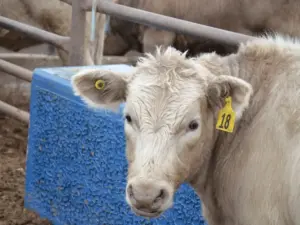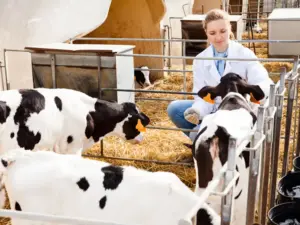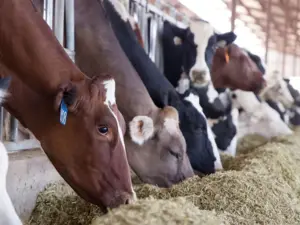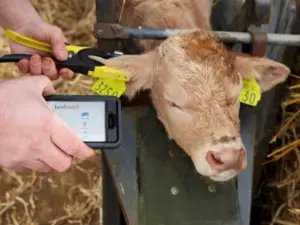Introduction:
Cow ear tagging is an integral aspect of modern livestock management. It provides a systematic and efficient means of identification. The practice has evolved, incorporating improved technology to enhance the identification process. In this comprehensive exploration, we will examine cow ear tagging.
Best Practices for Ear Tagging Cows- Steps To Follow

Step 1: Gather the Equipment
Before embarking on the ear tagging process, gather all the necessary equipment. This typically includes:
- Ear Tags: Choose appropriate ear tags based on your needs. They come in various materials, shapes, and sizes. Common materials include plastic and metal, with options for visual or electronic tags.
- Tag Applicator: Invest in a reliable tag applicator designed for the type of ear tags you are using. Applicators come in different styles, such as T-bar, pistol grip, or squeeze-handle applicators.
- Disinfectant Solution: Use disinfectant to clean the ear tag applicator and the cow’s ear while ear tagging cows. This ensures a clean and sterile environment.
- Identification Records: Maintain accurate records of each cow’s identification number, tagging date, and relevant information for future reference.
Step 2: Plan and Prepare
Planning is crucial for a smooth and efficient ear tagging process. Consider the following factors:

- Age of the Cows: It is advisable to tag calves at a younger age to minimize stress and discomfort. However, if tagging older cows, be cautious of their size and strength.
- Health Status: Before ear tagging cattle, ensure that the cows are healthy and disease-free. Avoid tagging sick or stressed animals to prevent complications.
- Weather Conditions: Choose a calm and dry day for ear tagging. Adverse weather conditions can lead to complications and stress for the cows and the handlers.
Step 3: Restraining the Cow
Proper restraint is essential to guarantee the safety of both the cow and the handlers. Depending on the facilities available, there are several methods to restrain a cow:

- Chute or Crush: A cattle chute or crush provides a secure and controlled environment for ear tagging. The cow is guided into the chute, where it can be safely restrained, minimizing movement.
- Headgate: If using a headgate for cattle tags, ensure it is properly adjusted to secure the cow’s head without causing discomfort. This allows easy access to the ears for tagging.
- Manual Restraint: In some situations, manual restraint may be necessary. This involves having additional handlers to secure the cow by holding a lead rope or halter.
Step 4: Cleaning the Equipment:
Before initiating the ear tagging process, clean and disinfect the tag applicator. This helps prevent infections and ensures a hygienic environment for the cows.
- Dip or Spray Applicator: Use a disinfectant solution to dip or spray the tag applicator thoroughly. Pay attention to all parts that come into contact with the cow’s ear.
- Disposable Gloves: Wear disposable gloves throughout the ear tagging process. Maintain cleanliness and prevent the transfer of germs.
Step 5: Identifying the Tagging Location
Identifying the correct location for cattle tags is crucial for the tag’s visibility and the cow’s comfort. The commonly recommended location is the middle one-third of the ear.
- Avoid Major Blood Vessels: Be cautious of major blood vessels in the ear, which can lead to excessive bleeding. The ideal location is between the main veins and arteries.
- Consistent Placement: Ensure consistent placement of ear tags within the herd for uniformity and easy identification.
Step 6: Applying the Ear Tag
Now that the preparations are complete, proceed with the ear tagging process:
- Position the Cow: Position the cow in a way that provides easy access to the ear for tagging. Ensure the head is securely restrained to prevent sudden movements.
- Grasp the Ear: Gently grasp the ear at the desired tagging location, using your non-dominant hand to hold it steady.
- Insert the Applicator: Put the cattle ear tags applicator in your dominant hand. Insert the tag’s applicator pin through the designated area on the ear.
- Apply Pressure: Apply steady and even pressure on the applicator handles to pierce the ear and secure the tag.
- Release the Tag: Once the tag is securely in place, release the applicator’s handles. Some tags may require additional steps, such as twisting or locking, to ensure proper attachment.
- Check for Bleeding: After tagging, check for any signs of bleeding. If bleeding occurs, apply gentle pressure to the affected area until it stops.
Step 7: Recording Information
Maintaining accurate records is crucial for efficient herd management. Immediately record the following information for each cow:

- Identification Number: Assign a unique identification number to each cow and record it in your database.
- Tag Type: Note the type of cattle ear tags used, whether visual, electronic, or a combination of both.
- Date of Tagging: Document the date when each cow is tagged. This information is essential for tracking the cow’s history and age.
- Additional Notes: Any additional information relevant to the cow. These include birth date, parentage, or health status.
Step 8: Post-Tagging Care
After tagging is complete, provide the cows with post-tagging care to minimize stress and promote healing:
- Release from Restraint: Gently release the cow from the restraint, allowing it to move freely.
- Monitor for Discomfort: Keep a close eye on the tagged cows for any signs of discomfort or irritation. If needed, provide additional care or treatment.
- Check Tags Regularly: Periodically check the ear tags to ensure they remain securely attached. Replace any damaged or loose tags promptly.
- Follow-Up Vaccinations: Schedule any required vaccinations or treatments following the ear tagging process.
The Significance of Cow Ear Tagging
Identification and Traceability:
Ear tags for cows are crucial for individual identification within a herd. Each tag bears a unique number or code that serves as a distinct identifier for a particular animal. This is especially important for traceability. It allows farmers to track an animal’s health records, breeding history, and movements throughout its lifespan. In case of disease outbreaks, rapid and accurate identification becomes essential. It will help in containment and prevention.
Record-Keeping and Data Management:
Ear tags for cattle facilitate the maintenance of comprehensive records for each cow in a herd. This includes vital information such as birthdate, vaccination history, and genetic lineage. Accurate record-keeping is essential. It helps in making informed decisions related to breeding programs. It also helps in health management and overall herd productivity.
Regulatory Compliance for Cow Ear Tags:
Many countries and regions have established regulations. They all require the identification of livestock. And ear tagging is a widely accepted method for Compliance. These regulations are in place to ensure the safety of the food supply chain. They monitor disease outbreaks and maintain a high standard of animal welfare.
Technological Advancements in Cow Ear Tagging
RFID Technology:
Radio-frequency identification (RFID) has revolutionized how livestock are identified and managed. RFID ear tags contain a small chip that stores a unique identification number. This technology allows for quick and contactless scanning for cattle ear tags. It reduces the time and effort required for manual identification. It also facilitates automated data collection. This integrates with management software and real-time monitoring of individual animals.
GPS Tracking for Cow Ear Tags:
Some advanced electronic ear tags for cattle come equipped with GPS tracking capabilities. They provide real-time location data for each tagged cow. This feature is particularly valuable for extensive grazing systems. This allows farmers to monitor the movements of their herd. It helps identify potential issues such as straying or predation.
Health Monitoring Sensors:
Modern cow ear tags can incorporate health monitoring sensors. These provide insights into an animal’s vital signs, activity levels, and overall well-being. These data enable timely intervention and minimize the impact on individual animals and the entire herd.
Integration with Management Software:
The integration of the cow ear tagging systems with management software has streamlined herd management. These platforms allow farmers to input, analyze, and visualize data related to each cow. This makes making informed decisions on breeding, health interventions, and resource allocation easier.
Challenges and Considerations
Cost Implications:
The benefits of cow ear tagging are substantial. However, the initial investment in tagging equipment and technology can be a barrier for some farmers. The long-term advantages in terms of improved management often outweigh the upfront costs.
Human Resource and Training:
Implementing an effective cow ear tag system requires proper training for farm personnel. This includes instruction on the tagging technique and equipment usage. Adequate training ensures that the process is carried out efficiently.
Data Security and Privacy:
With the integration of technology, addressing concerns related to data security and privacy is a must. Protect information stored in electronic databases, especially those containing health and genetic data, against unauthorized access and potential misuse.
Conclusion:
Cow ear tagging is an essential practice in modern livestock management. This provides a systematic and efficient means of identification. It contributes to overall herd optimization. Technological advancements have enhanced the effectiveness of this practice. These include RFID, GPS tracking, and health monitoring sensors. Farmers can ensure accurate identification, streamlined record-keeping, and improved traceability. While challenges exist, the long-term benefits make cow ear tagging a valuable investment for efficient livestock operations. As technology continues to evolve, integrating innovative solutions will further contribute to advancing cow ear tagging practices.
